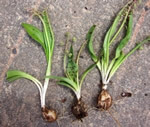- Choctaw L.
- News and advice on hydroponics culture indoors and outdoors!
- 98 likes
- 36049 views
- 0 comments

Scilla hyacinthina (Roth) J. F. Macbr.
Bulb sub globose, tunicate, tapering above, leaves radical, lorate, base attenuate and sheathing, apex obtuse, mucronate, purplish-blotched above; scapes 1-3; racemes to 10cm, 30-60 flowered; bracts scarious; bracteoles adnate to base of pedicel; flower bisexual; perianth deeply – lobed; lobes 3+3; pinkish green, oblong, sub equal; stamens 6, adnate to perianth base; ovary 3 celled and 3-lobed; capsule sub globose, loculicidal; seed sub globose.
Vernacular Name: Tamil – Narivenkayam Eng. - South Indian Squill
Family: Hyacinthaceae
Mode of utilization (Traditional Usages):
For Human (Traditional uses):

Paste of bulbs is applied over wounds till complete curing. The paste also used to help welding broken bones.
Squill has shown to have cardiac effects similar to digoxin, including positive inotropic and negative chronotropic effects. The aglycones in squill are poorly absorbed from the GI tract and are therefore less potent than digitalis cardiac glycosides. Additional cardiovascular properties include reducing left ventricular diastolic pressure and reducing pathologically elevated venous pressure
For plants:
The whole plant is taken and allowed to ferment in rice water. The fermented extracts are used increase resistance to various plant stresses. Prevents the cell damages from various environmental stress (Balance Plant/Air/Soil. Regulates a uniform absorption and circulation of nutrients within the treated plant (Balance Plant/Soil).
![]()

Comments (0)